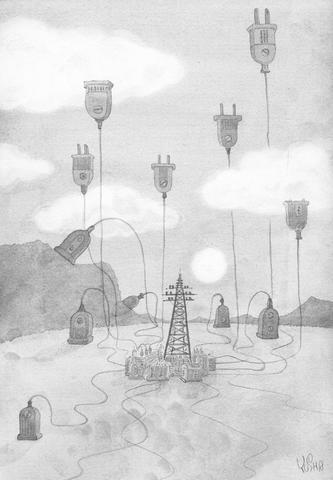It has become one of the most serious hurdles in America's project to reshape Iraq: How can a force that spent billions sending its troops to war still not manage to keep the lights on?
Restoring electrical power is the cornerstone of the West's reconstruction efforts. With electricity comes air-conditioning in the summer, heating in winter, water purification facilities, revived oil and gas production, functioning hospitals and getting industrial plants back on line. All this will do more than any number of troops to restore security and halt the frustration behind the continued wave of guerrilla attacks.

Given the scale of the task, the architects of America's war appear remarkably untroubled.
"For a city that's not supposed to have power, there's lights all over the place. It's like Chicago," US Secretary of Defense Donald Rumsfeld said earlier this month after a night-time Blackhawk helicopter tour over Baghdad.
Unfortunately, Chicago it is not. Iraq's current total power output is 3,362MW. That may not be far off the 4,000MW being produced just before the war, but it falls a long way short of today's demand, estimated at between 7,000MW and 20,000MW.
There is no quick fix, and no one understands why better than Zyad al-Azzawi. He is one of Iraq's most respected power engineers.
After the first Gulf war, the British-educated engineer was seconded to join the emergency reconstruction committee set up by former Iraqi president Saddam Hussein to rebuild Iraq as quickly as possible. The task was colossal. Power stations and water plants had been destroyed. Yet within a few months al-Azzawi and his fellow engineers rebuilt the stations, patched up the water plants and got the electricity back on line and oil pumping again.
What happened next lies at the heart of America's current troubles: largely because of UN sanctions there followed 12 years of maintenance shortcuts, spare-part shortages, crude patchwork repairs and pressure to squeeze as much power as possible from an ageing grid. Few major power stations were built over the decade, even though demand increased. This legacy of crippled infrastructure remains perhaps the biggest hurdle to the reconstruction efforts.
"Now you need to completely rehabilitate the power system," al-Azzawi says.
This means that it will not be weeks or months but several years before a consistent power supply is established -- and before other vital services, like healthcare and water purification, can be restored to their pre-1991 condition. Washington is at last experiencing for itself the impact of a decade of sanctions.
Many of today's most serious problems have the smallest origins. A barely noticeable increase in water impurities, because of inefficient treatment plants, meant a growing problem of scaling in power station boiler plants. That means more frequent repairs, which reduce output.
Al-Azzawi and his colleagues were under pressure to increase the power supply after the first Gulf war and so Iraq's power frequency was reduced from 50 hertz to 49; this made little difference in people's homes, but it meant that turbines were operating under dangerous conditions. Other parts of the system are so old they simply can no longer take the strain. A fire in the Hartha power station in southern Iraq this month was blamed on a burned-out copper cable that was at least 25 years old. That one fire was enough to reduce by two-thirds the power that will be supplied in the province of Basra for at least a month.
But all cannot be blamed on poor infrastructure. During the 1991 rebuilding programme there was little looting. This time around, illicit street markets are filled with wires, cables, pipes, light bulbs, sockets, doors, brass fittings -- anything looters could strip away. So much copper wire has been stolen and sold that it has dented world prices.
Corruption has plagued the oil industry, and sabotage continues to be a problem. Power lines, particularly in the troubled Sunni regions north and north-west of Baghdad, are still frequently knocked down to disrupt supply. Iraqi engineers are wary of rushing out to repair fallen pylons for fear of guerrilla attacks. Oil pipelines have been hit, and water pipes have also been targeted by saboteurs.
Protecting the power lines and pipelines would require vast security operations. The same security concerns are also keeping many western contractors and much-needed expatriate Iraqi businessmen away.
The US and Britain were culpably slow to realize the scale of the project. Initially, the task was given to military men: America's Jay Garner and Britain's Tim Cross. Only in mid-June did Washington and London wake up to the need to increase the power of what became the Coalition Provisional Authority, as well as its size and experience.
Cross was replaced by Andy Bearpark, a British development expert who spent three years heading reconstruction efforts in Kosovo for the EU. From his unassuming office (a walk-in closet off a guest bedroom in Saddam's main Baghdad palace), Bearpark is leading the reconstruction efforts. He insists it is unfolding at a faster pace than in any other post-conflict situation. Across Iraq thousands of small-scale, quick projects are under way, while the longer-term deals to repair power stations or build new ones are being negotiated.
Al-Azzawi and other Iraqi engineers believe the best solution would be to import enough generators to temporarily produce the hundreds of megawatts needed to fill the shortfall. Indeed, dozens of back-up generators have been installed at hospitals, water plants and telecoms exchanges. But to rely any more heavily on generators would require such a large supply of diesel fuel, Bearpark argues, as to be inefficient and impractical. Already there are serious diesel shortages. Some electricity is being imported from Syria and Turkey, but the restrictions of Iraq's infrastructure limit how much can be absorbed.
In the end, there is no better alternative than simply to repair and strengthen the existing power grid, however long it takes (at least three years) and however much it costs (at least US$10 billion).
"People wanted it to be better straight away," Bearpark says, "but that is simply unachieveable." Regardless of Rumsfeld's bravado, it will be years before the lights stay on in Iraq.

Donald Trump’s return to the White House has offered Taiwan a paradoxical mix of reassurance and risk. Trump’s visceral hostility toward China could reinforce deterrence in the Taiwan Strait. Yet his disdain for alliances and penchant for transactional bargaining threaten to erode what Taiwan needs most: a reliable US commitment. Taiwan’s security depends less on US power than on US reliability, but Trump is undermining the latter. Deterrence without credibility is a hollow shield. Trump’s China policy in his second term has oscillated wildly between confrontation and conciliation. One day, he threatens Beijing with “massive” tariffs and calls China America’s “greatest geopolitical
Chinese Nationalist Party (KMT) Chairwoman Cheng Li-wun (鄭麗文) made the astonishing assertion during an interview with Germany’s Deutsche Welle, published on Friday last week, that Russian President Vladimir Putin is not a dictator. She also essentially absolved Putin of blame for initiating the war in Ukraine. Commentators have since listed the reasons that Cheng’s assertion was not only absurd, but bordered on dangerous. Her claim is certainly absurd to the extent that there is no need to discuss the substance of it: It would be far more useful to assess what drove her to make the point and stick so
The central bank has launched a redesign of the New Taiwan dollar banknotes, prompting questions from Chinese Nationalist Party (KMT) legislators — “Are we not promoting digital payments? Why spend NT$5 billion on a redesign?” Many assume that cash will disappear in the digital age, but they forget that it represents the ultimate trust in the system. Banknotes do not become obsolete, they do not crash, they cannot be frozen and they leave no record of transactions. They remain the cleanest means of exchange in a free society. In a fully digitized world, every purchase, donation and action leaves behind data.
Yesterday, the Chinese Nationalist Party (KMT), once the dominant political party in Taiwan and the historic bearer of Chinese republicanism, officially crowned Cheng Li-wun (鄭麗文) as its chairwoman. A former advocate for Taiwanese independence turned Beijing-leaning firebrand, Cheng represents the KMT’s latest metamorphosis — not toward modernity, moderation or vision, but toward denial, distortion and decline. In an interview with Deutsche Welle that has now gone viral, Cheng declared with an unsettling confidence that Russian President Vladimir Putin is “not a dictator,” but rather a “democratically elected leader.” She went on to lecture the German journalist that Russia had been “democratized